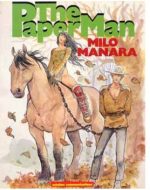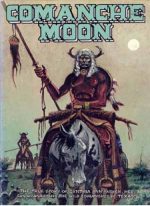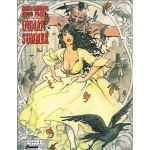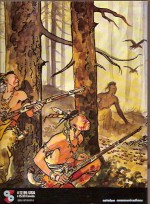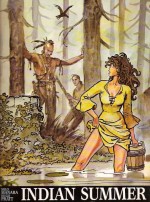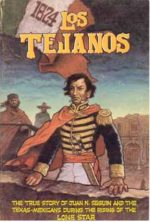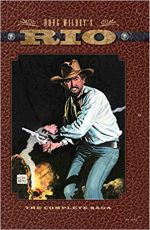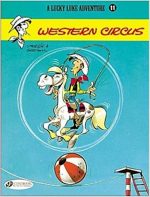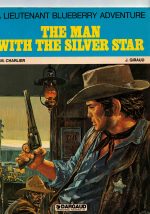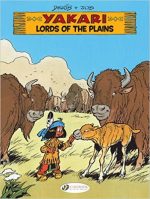

By Scott Snyder, Rafael Albuquerque, Stephen King & various (Vertigo)
ISBN: 978-1-4012-2830-9Â Â Â Â Â Â Â Â Â Â Â Â Â Â Â Â Â 978-1-4012-2974-0 (SC)
In myth, literature and entertainment, there are many sorts of vampires. Here’s one species that’s a superbly grounded counterpoint to the scarlet deluge of lovey-dovey, kissey-poo tales of forbidden love between innocent modern maids and moody, tragic carriers of the Curse of the Night’s Children: one that uses for its themes Darwinian Survival of the Fittest, old-fashioned Revenge and the ultimate grisly example of Manifest Destiny; all played out against the chillingly familiar backdrop of the bloody birth of a modern nation…
In Scott Snyder & Rafael Albuquerque’s first narrative arc, augmented and supplemented here by a stunning sidebar storyline from the functionally mythical Stephen King (who also provides a trenchant Introduction with ‘Suck on This’) – the kind of vampires that you should rightly beware of are introduced and explained, but although there are love stories in this series they’re probably not the sort you want your impressionable kids to read…
The sinister suspense begins with ‘Big Break’ as, in the Hollywood of 1925, struggling but popular and ambitious would-be starlets Pearl Jones and Hattie Hargrove follow their dream of celluloid stardom, working days as bit-players in movie mogul D. B. Bloch‘s latest silent epic.
The girls have only been best friends for a short while but shared hardship makes them closer than sisters even if, too often, Pearl is distracted by itinerant musician Henry Preston and the aggravatingly persistent and obnoxious drifter who hangs out near their Ladies-Only boarding house.
The actresses’ careers seem destined to blossom when leading man Chase Hamilton invites the fame-hungry gamins to one of Bloch’s legendary Producer’s Parties. Despite shaded warnings from their laconic stalker, Pearl and Hattie attend but when the unctuous Chase takes the Jones girl aside to meet D. B. it isn’t the kind of assignation she expects…
Reeling with horror, the feisty actress finds herself a morsel and kickback-offering for a pack of wealthy European money-men who are literally blood-sucking monsters…
King & Albuquerque then take us back to the hoary days of 1880 and Sidewinder, Colorado, as veteran wordsmith Will Bunting relates the true story behind his novel ‘Bad Blood’ to a group of eager fans and historians…
The ancient scribbler recounts the fantastic yet apparently non-fictional tale of outlaw Skinner Sweet, a remorseless thief frustrating progress, killing good folks and stealing funds from sun-shy, Euro-trash millionaire railroad speculator Mr. Percy. When the psychotic bandit is finally captured by Pinkerton agent Jim Book and deputy Felix Camillo, the triumphant banker lays on a special train for a gaggle of journalists to record the victory of civilisation over lawlessness…
As the killer’s gang subsequently derails the train and massacres everyone who survived the crash, Skinner cruelly and casually takes time out to reveal how he killed Book’s wife…
Sweet then guns down Book and overwhelms Camillo, but is utterly unprepared for the attack of effete-seeming Percy who shrugs off fusillades of bullets before slaughtering them all. Skinner won’t die easily though, and in close combat with the fanged, gore-guzzling horror blows the European monstrosity’s eye out, consequently taking its blood into his own body before at last expiring…
Unknown to all, Bunting has seen everything and, as fully-healed Percy tends to Book and Camillo, wisely decides to say nothing of the horror he’s witnessed…
The Hollywood story then resumes with ‘Morning Star’ as Hattie and Henry discover Pearl is missing. Driving to the isolated mansion they discover her; ravaged, chewed to ribbons as if by some animal, yet inexplicably clinging to life.
Pearl wakes in the Morgue, having been visited by her mysterious stalker. Skinner Sweet has shared his unique blood with her and now, as the once-deceased actress listens in astonishment, the smirking ghoul explains some facts of life – and death – to her.
Like himself she has been attacked by ancient, old-world vampires, and by sharing their blood – accidentally in his case but quite deliberately when Sweet bestowed his own kiss upon her – Pearl has become a new kind of hybrid-bloodsucker, perfectly evolved to inhabit the New World, with completely different weaknesses to the old guard and, hopefully, sharing Sweet’s lust for revenge, taste for chaos and hunger for life…
After giving her a quick lesson on the differences between the European nosferatu who have carved themselves an almost unassailable position of closeted wealth and power in the young nation and the new American Vampires (now numbering two), the morally bankrupt wanderer takes off, leaving his hungry offspring to sink, swim or stand on her own shape-shifting, taloned feet…
He does leave a present, however: locked in her closet, Chase Hamilton quickly realises he is about to pay for all his many sins…
‘Deep Water’ finds author Will Bunting also in 1925, talking about the re-issue of his fantastic novel to a store full of avid fans. The tale, describing the iconic life of heroic Jim Book and his battle against vampire outlaw Skinner Sweet, resumes at the point when the infected owlhoot wakes up in his own grave. Far above him the cabal of expatriate vampires secretly dominating America’s nascent financial system continue accruing wealth and power and insouciantly turn the entire town of Sidewinder into Colorado’s latest reservoir and boating lake…
For nearly thirty years Book continues with his peacekeeping profession and eventually Camillo is elected Mayor of new town Lakeview. More worryingly Bunting had turned the tale of Sweet and the vampires into a popular dime-novel so sensation-seekers and treasure-hunters regularly dredge the man-made mere for souvenirs of the infamous outlaw…
One day in 1909 a couple of them unearth the now legendary badman’s buried, sunken coffin and unleash a rabid horror unlike anything ever seen in the world before: a leech unaffected by running water, stakes or sunlight. Hungry for revenge and sustenance Skinner Sweet emerges into a new America and starts hunting old “friends†he owes a debt to…
In Tinsel Town meanwhile, Pearl returns to her lodgings and tells shell-shocked Hattie to flee before continuing her own quest for vengeance in ‘Rough Cut’. The immortal Euro-cabal are, as usual, discussing what to do about their personal nemesis Sweet and his protracted annoyance, unaware they have a far more pressing problem. That all changes after the unstoppable and infinitely superior Pearl butchers three of them. Without knowing what could kill this New World species of vampire, the clique resorts to age-old stratagems even as Miss Jones – resuming mortal form – turns to Henry for a little comfort and support…
Just then the phone rings and Bloch demands that she surrender herself or Hattie will die horribly…
Back in 1909 Sweet’s ‘Blood Vengeance’ eliminates every human in Lakeview and proclaims his intentions to a horrified coterie of haughty, privileged, old-world bloodsuckers who previously believed themselves the planet’s apex predators. Even so, the resurgent outlaw has more pressing business. Before the last man in town died, Sweet made him send a telegram to Jim Book…
‘Double Exposure’ sees Pearl desperately negotiating for Hattie’s life, knowing surrender only leads her to becoming the cabal’s eternal, experimental lab rat. She is utterly unaware she has already been betrayed by someone close to her: someone pitifully greedy and unable to resist the subtle pressures and obvious blandishments of the European ancients.
However, even bushwhacked, mysteriously weakened and brutally assaulted, Pearl, with the aid of her last true friend, turns the tables and even destroys Bloch’s fortress before escaping to prepare for one last showdown…
The writer’s tale is also approaching a climax as ‘One Drop of Blood’ finds Book, Felix, the young Bunting and Camillo’s daughter Abilena hunting Sweet through the hellish ruins of Lakeview just as the bloodthirsty travesty discovers that his powers and energies are unaccountably waning. Watching unsuspected from a distant position of seclusion, “Euro-Vamps†bide their time and witness the shocking finale as the valiant comrades use dynamite to bury the debilitated devil in a deep mine-shaft under tons of unyielding rock – but not before the sadistic Skinner deliberately infects Book with his own tainted, mutagenic blood…
Pearl’s story in this first stunning volume concludes in a sustained spray of scarlet gore as she climactically confronts Bloch and his surviving comrades only to face one final tragic betrayal in ‘Curtain Call’ whilst ‘If Thy Right Hand Offend Thee…‘ discloses Book’s climactic battle with the cursed thirst Sweet had inflicted upon him, even as unstoppable Skinner enjoys one last chat with the Euro-leech who created him…
The time-distanced yet parallel tales then coincide and conclude with a hint of foreboding; presaging more horrors in the days and decades to come…
This initial creepy, compelling chronicle also includes a pithy Afterword from Snyder, a welter of variant covers by Albuquerque, Jim Lee, Bernie Wrightson, Andy Kubert, JH Williams III and Paul Pope, a feature on the script-to-art process and 6 pages of designs and sketches by the supremely skilled and multi-faceted Albuquerque to delight and impress all fans of truly mature supernatural thrills and chills.
Far more True Blood than Twilight and substantially closer to Sam Peckinpah than John Ford or Tod Browning, this lightning-paced, sardonically gory excursion into blood and sand and love and death is a spectacular, absorbing thrill-riot by two of the industry’s best talents, backed up and covered by an absolute master of tone and terror, combining to craft a splendid, sordid, sexy and utterly spellbinding saga, riddled with far deeper metaphors than “unrequited love sucksâ€.
American Vampire offers solid screams and enchantingly fresh ideas all fear-fiends will find irresistible, making this modern classic an absolute “must-have†and a certain reminder that there are such things as monsters and some beasts just should not be tamed…
© 2010, Scott Snyder and Stephen King. All Rights Reserved.
